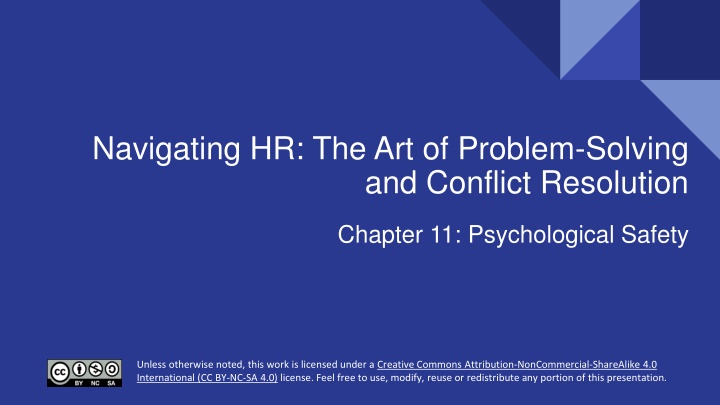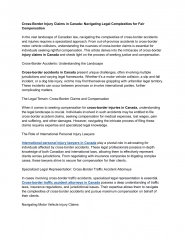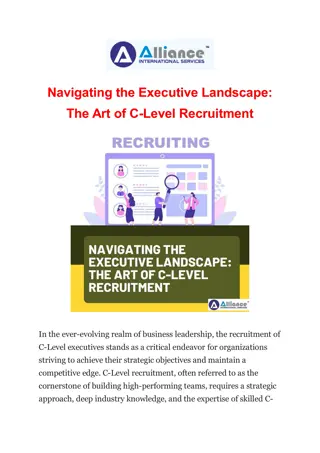
Mastering Difficult Conversations and Conflict Resolution in HR
Learn the art of navigating challenging workplace conversations and conflicts with this chapter on psychological safety, planned vs. unplanned dialogues, and best practices for HR professionals. Discover how to address issues promptly, be prepared for any situation, and maintain confidentiality while achieving resolutions that promote understanding and progress.
Download Presentation

Please find below an Image/Link to download the presentation.
The content on the website is provided AS IS for your information and personal use only. It may not be sold, licensed, or shared on other websites without obtaining consent from the author. If you encounter any issues during the download, it is possible that the publisher has removed the file from their server.
You are allowed to download the files provided on this website for personal or commercial use, subject to the condition that they are used lawfully. All files are the property of their respective owners.
The content on the website is provided AS IS for your information and personal use only. It may not be sold, licensed, or shared on other websites without obtaining consent from the author.
E N D
Presentation Transcript
Navigating HR: The Art of Problem-Solving and Conflict Resolution Chapter 11: Psychological Safety Creative Commons Attribution-NonCommercial-ShareAlike 4.0 International (CC BY-NC-SA 4.0) Creative Commons Attribution-NonCommercial-ShareAlike 4.0 International (CC BY-NC-SA 4.0) Unless otherwise noted, this work is licensed under a Creative Commons Attribution-NonCommercial-ShareAlike 4.0 International (CC BY-NC-SA 4.0) license. Feel free to use, modify, reuse or redistribute any portion of this presentation.
11.0 Learning Outcomes In this chapter, we will: Identify best practices in planned and unplanned difficult conversations. Explain the meaning and importance of psychological safety at work. Apply psychological safety practices to a workplace scenario.
11.2 The Lesson: Navigating the Difficult Conversation Workplace Conflicts: Conflicts often arise from differences in opinion, approach, work ethic, or personality, as well as misunderstandings through communication methods like email. Serious Conflicts: Issues such as theft, discrimination, ethics, and harassment require formal investigations and are considered more serious. Difficult Conversations: Conversations addressing conflicts are challenging due to expectations that they may not go well. Planned vs. Unplanned Conversations: Planned: HR professionals have time to prepare. Unplanned: HR professionals are caught in problematic or heated discussions without warning. "Get Comfortable Being Uncomfortable": HR professionals frequently face uncomfortable and awkward situations, making it essential to manage these effectively.
11.2 The Planned Difficult Conversation Act Quickly: Address issues promptly to prevent escalation and show commitment to resolution. Be Prepared: Research and outline key points to keep the conversation focused and effective. Location and Time: Choose a private, suitable time and place to ensure confidentiality and minimal disruption. Include a Witness: Involve a trusted, confidential individual when needed for safety or documentation. Focus on Understanding: Ensure the employee understands the concerns and expectations, even without full agreement. Documentation and Confidentiality: Record key points and outcomes while maintaining strict confidentiality. Follow-Up Discussion: Revisit the issue to confirm progress and address any remaining concerns.
11.2 The Unplanned Difficult Conversation Act Quickly: Address impromptu conversations immediately to prevent escalation, relying on experience to navigate the situation. Be Prepared: Accept the lack of preparation time and embrace the challenge of handling unexpected discussions. Location and Time: Quickly move the conversation to a private, confidential setting, even if it begins in an unsuitable area. Include a Witness: If necessary, involve a trusted individual during the discussion for safety or documentation purposes. Focus on Understanding: Ensure the employee understands the discussion and expectations, even without agreement. Documentation and Confidentiality: Record the conversation thoroughly and maintain confidentiality as with planned discussions. Follow-Up Discussion: Revisit the conversation to confirm progress and address any remaining concerns.
11.2 The FACED Approach Step 1: Identify the Problem Understand the issue by defining the undesirable situation and its costs, while considering other perspectives. Step 2: Determine What s at Stake Assess potential costs and benefits, and consider how miscommunication impacts others. Step 3: Explore Options Ask "What could we do?" to generate solutions, using past experiences and expert advice. Step 4: Choose the Best Solution Evaluate options based on timing, cost, difficulty, and impact, and select the most effective one. Step 5: Communicate the Solution Develop and deliver a clear plan to propose, justify, or implement the solution.
11.3 Spotlight on Human Resources Skills Foster Inclusivity and Belonging: Build a culture where every employee feels valued and included, supported by open and transparent communication. Embrace Diverse Perspectives: Leverage diverse viewpoints to drive innovation and adaptability, while addressing biases and demonstrating cultural competence. Promote Respect and Conflict Resolution: Encourage constructive dialogue, mutual understanding, and respectful behaviour to prevent harmful interactions. Provide Support and Allyship: Support colleagues facing challenges and rely on leadership to model and uphold inclusive behaviour. Commit to Training and Awareness: Invest in education and leadership efforts to embed inclusive practices and psychological safety into the workplace culture. Lead by Example: Leadership must actively model inclusive behaviours and set clear expectations, reinforcing the importance of inclusivity and psychological safety across the organization.
11.3 Thinking About Trust Psychological Safety Fosters Trust and Collaboration: It encourages individuals to express themselves authentically, driving innovation and organizational success. Marginalized Groups Face Higher Stakes: Trust is especially critical for minorities, as they often experience a greater emotional and cognitive burden in the workplace. Cultural Awareness Enhances Safety: Acknowledging and respecting cultural differences is essential for fostering an inclusive environment where diverse perspectives thrive. Psychological safety by Shauna Roch, CC BY- NC-SA 4.0
11.3 The Dimensions of Cultural Safety Management and Supervision: Psychological safety is reflected in the trust and support management provides, fostering positive relationships and listening to employee concerns. Communication Between Employees: Clear and transparent communication is essential for ensuring employees understand their roles and workplace regulations. Authenticity in the Workplace: Employees should feel comfortable being themselves, with respect for individual differences valued in the work environment. Employee Discretion: Employees should feel empowered to make decisions and take reasonable risks, with support for their autonomy in how they work. Attitude and Positivity: A positive work environment where employees feel valued, confident in their roles, and recognized for their contributions enhances psychological safety.
11.6 Key Takeaways Difficult conversations may be unplanned or planned A planned difficult conversation provides the Human Resources professional with time to gather information and prepare talking points An unplanned, difficult conversation relies on the skills of the Human Resources professional to react professionally and guide the conversation without any notice It is essential to select the best time and place to have a difficult conversation and invite a witness, such as the employee s direct manager Topics that require a problematic conversation often include theft, discrimination, ethics, and harassment. Psychological safety is a basic need every organization needs to provide to all employees. To ensure psychological safety, leaders must ensure employees feel safe coming forward to speak with the direct managers. Employees must trust their leaders will keep the information confidential to feel safe unless they must make a statement in a formal workplace investigation. Confidentiality is paramount, meaning information isn t shared with anyone who isn t directly involved. For example, information may need to be shared with Human Resources but not with co-workers.



















